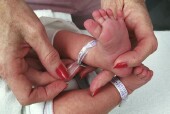
TUESDAY, July 27 (HealthDay News) — Infants born even a few weeks early run the risk of developing breathing problems compared with full-term babies, a new study finds.
Late preterm births — defined as between the 34th and 37th weeks of pregnancy — account for about 9 percent of all infants born in the United States, the researchers said. And too often, they are the result of a planned Cesarean deliveries, one expert noted.
However, delivering even a bit before term may carry risks for baby, the researchers reported.
“Our study verifies that late preterm birth neonates delivered from 34 to 37 weeks have much higher risks for respiratory complications than infants delivered from 38 to 40 weeks gestation,” said lead researcher Dr. Judith U. Hibbard, a professor of obstetrics and gynecology at the University of Illinois at Chicago. “The risk for respiratory [illness] decreases with each advancing week of gestation.”
The study provides good information for parents on respiratory outcomes for newborns, Hibbard said.
“In addition, it may discourage obstetricians and providers from delivering women earlier without good indications and may prompt further research into why there is such a high late preterm birth rate in the U.S. — and what interventions we might undertake to decrease it,” she said.
The report is published in the July 28 issue of the Journal of the American Medical Association.
For the study, Hibbard’s team looked at data on almost 234,000 deliveries performed between 2002 and 2008 at 19 hospitals across the United States.
Among the more than 19,000 late preterm births observed in the study, 7,055 babies had to be placed in neonatal intensive care units. Of these, 2,032 suffered from respiratory problems, the researchers found.
In contrast, of the nearly 166,000 babies born at term, 11,980 were admitted to a neonatal intensive care unit and of these only 1,874 had breathing problems, the researchers noted.
The most common breathing problem among the late preterm infants was respiratory distress syndrome, a severe lung disease of newborns. This affected 390 (10.5 percent) of those born at 34 weeks and 140 (0.3 percent) of those born at 38 weeks, Hibbard’s group found.
The next most common problem was rapid breathing, called transient tachypnea, which affected 236 (6.4 percent) of babies born at 34 weeks and 207 (0.4 percent) of those born at 39 weeks.
Cases of pneumonia also decreased the closer to full term babies were born, dropping from 1.5 percent at 34 weeks to 0.1 percent at 39 weeks, the researchers found.
This was also the case for respiratory failure, which dropped from 1.6 percent among infants born preterm to 0.09 percent for infants born at 40 weeks.
For infants born at 34 weeks, the risk of developing respiratory distress syndrome rose 40-fold, but decreased sharply as the delivery neared full term, Hibbard’s group says.
However, “even at 37 weeks, the odds of respiratory distress syndrome were still threefold greater than that of a 39- or 40-week birth. Similar patterns were seen for transient tachypnea of the newborn, pneumonia, standard or high-frequency ventilator requirements, and respiratory failure,” the researchers wrote.
Commenting on the study, Dr. Eduardo Bancalari, director of the division of neonatology at the University of Miami Miller School of Medicine, said that, “this is not surprising. The right time to be born is at 40 weeks and anytime before that the risk increases.”
He believes there’s been a huge amount of focus on infants born very early, but “people have forgotten that even a 36- or 37-[week] gestational delivery is also at higher risk.”
Bancalari stressed that some infants do need to be delivered preterm, if there are medical issues with the mother or the baby. “But at the same time, there are a good number of babies that are born premature because there is a trend to do preterm, planned deliveries,” he said.
The increase in the number of planned Cesarean deliveries is worrisome, Bancalari said. “In some hospitals, it is 50 or 60 percent. That is completely out of control,” he said. “Because these are planned C-sections, some of them are done prematurely. It shouldn’t be, but it happens.”
More information
For more information on premature birth, visit the March of Dimes.

